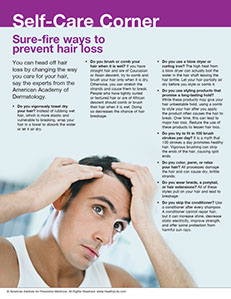SYMPTOM CHECKER
CONDITIONS
Male
Female
Child
Arm, Hand & Shoulder Concerns
Legs & Feet Concerns
Dental & Mouth Concerns
Ear & Nose
Eye Conditions
Head Conditions
Arm, Hand & Shoulder Concerns
Legs & Feet Concerns
Front
Back
Arm, Hand & Shoulder Concerns
Dental & Mouth Concerns
Ear & Nose
Eye Conditions
Head Conditions
Arm, Hand & Shoulder Concerns
Dental & Mouth Concerns
Ear & Nose
Eye Conditions
Head Conditions
Front
Back
Arm, Hand & Shoulder Concerns
Neck Links
Head & Neck Concerns
Arm, Hand & Shoulder Concerns
Neck Links
Head & Neck Concerns
Front
Back
Online Clinic
Wise Healthcare
Sure-fire ways to prevent hair loss
Print on Demand
You can head off hair loss by changing the way you care for your hair, say the experts from the American Academy of Dermatology.
• Do you vigorously towel dry your hair? Instead of rubbing wet hair, which is more elastic and vulnerable to breaking, wrap your hair in a towel to absorb the water or let it air dry.
• Do you brush or comb your hair when it is wet? If you have straight hair and are of Caucasian or Asian descent, try to comb and brush your hair only when it is dry. Otherwise, you can stretch the strands and cause them to break. People who have tightly curled or textured hair or are of African descent should comb or brush their hair when it is wet. Doing so decreases the chance of hair breakage.
• Do you use a blow dryer or curling iron? The high heat from a blow dryer can actually boil the water in the hair shaft leaving the hair brittle. Let your hair partially air dry before you style or comb it.
• Do you use styling products that promise a long-lasting hold? While these products may give your hair unbeatable hold, using a comb to style your hair after you apply the product often causes the hair to break. Over time, this can lead to major hair loss. Reduce the use of these products to lessen hair loss.
• Do you try to fit in 100 brush strokes per day? It is a myth that 100 strokes a day promotes healthy hair. Vigorous brushing can strip the ends of the hair, causing split ends.
• Do you color, perm, or relax your hair? All processes damage the hair and can cause dry, brittle strands.
• Do you wear braids, a ponytail, or hair extensions? All of these styles pull on your hair and lead to breakage.
• Do you skip the conditioner? Use a conditioner after every shampoo. A conditioner cannot repair hair, but it can increase shine, decrease static electricity, improve strength, and offer some protection from harmful sun rays.
This website is not meant to substitute for expert medical advice or treatment. Follow your doctor’s or health care provider’s advice if it differs from what is given in this guide.
The American Institute for Preventive Medicine (AIPM) is not responsible for the availability or content of external sites, nor does AIPM endorse them. Also, it is the responsibility of the user to examine the copyright and licensing restrictions of external pages and to secure all necessary permission.
The content on this website is proprietary. You may not modify, copy, reproduce, republish, upload, post, transmit, or distribute, in any manner, the material on the website without the written permission of AIPM.
2021 © American Institute for Preventive Medicine - All Rights Reserved. Disclaimer | www.HealthyLife.com
















































